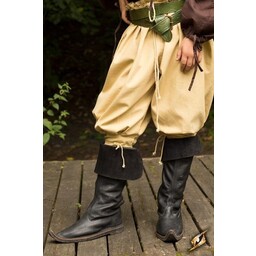Product description
This type of medieval boots was worn during around the fourteenth and fifteenth centuries. The point is longer according to the fashion of this time. People liked to wear poulaines, or shoes with very long toes. This fashion originated in Krakow, Poland, hence the name poulaines which can be translated as 'shoes according to Polish fashion'. The toes became longer and longer, and eventually laws came into force that limited the length of the shoes, for the safety of the wearers. These boots show a more modest toe length.
These boots are made from high quality vegetable tanned black leather and are very durable. They are suitable for late medieval reenactment. The soles have an inner layer of leather and an outer layer of rubber, so you have a firm grip on the ground and you do not slip easily unlike fully leather soles. At the heel, the soles are thicker and have a reinforcement so that they last longer.
At the back you can fasten the boots with leather laces. The leather flap can be worn according to your own wishes: folded or raised.
Details
Material: naturally colored leather, rubber, brass;
Colour: black;
Size: 37 up to 46 (size chart see below);
Boots height: approx. 42-45 cm;
Weight: approx. 1100 g;
Based on historical original;
Transport weight (gram): 2000" *
| Size | Sole length approx. |
| 37 | 24 cm |
| 38 | 24,5 cm |
| 39 | 25 cm |
| 40 | 25,5 cm |
| 41 | 26 cm |
| 42 | 27 cm |
| 43 | 27,5 cm |
| 44 | 28 cm |
| 45 | 29 cm |
| 46 | 29,5 cm |
This item is produced in limited quantities only. This means that every piece is unique. Sizes & finish may vary lightly from piece to piece.
Maintenance & care
Just as with weaponry, you can care for your shoes and leatherware by applying a little Ballistol after cleaning. This prevents the leather from drying out.
Be aware!
Shoes run small, so we recommend ordering a size larger.
Packaged with 100% recycled material
When packaging this item, we exclusively use 100% recycled plastic and recycled paper/cardboard from FSC certified forests. We reuse a large part of the material directly without the intervention of a recycling process.
Recycle the material by separating your waste:
1. Cardboard: separate or reuse your paper.
2. Plastic cushions, clothing bags and plastic tape: separate or reuse your plastic. If possible, pierce the cushions with a volume reduction needle.
3. Paper packaging for jewelry and small items: these have a plastic inner layer. Remove these, then separate your paper and plastic.




